The Violoncello da Spalla, a 21st-century aberration?
Alert: this article may seem a bit technical, but if you stay with me, it will make you very solid on your spalla beliefs.
In March 2020, Mark Vanscheeuwijck published an interesting article titled: “Violoncello and other Bass Violins in Baroque Italy”
I highly recommend it; it’s a good account of the birth of the modern violoncello and its influences in Europe. You will find good ideas of repertoire suitable for da Spalla and a clear exposition of what was probably not da Spalla, despite the higher range used.
In over 90 pages, Vanscheeuwick shows us the variety of instruments used at the time (and that were later all included under the word violoncello): big, small, four strings, five strings, with a variety of tunings. And a variety of possible techniques.
His work ends with a chapter titled:
The violoncello da Spalla, a 21st-century aberration?
Frankly speaking, being Vanscheeuwick a life-long scholar with deep experience, I expected something more than a couple of pages of assumptions with no quoted fact or sources. I hope this was due mainly to the lack of space than of intention and will come later in a more dedicated publication.
His main point is that Violoncello da Spalla shouldn’t be regarded as an instrument with specific organological features, but just one way, one of many possible ways, to play the bass of the violin family. Depending on the space and situation. Up to this, I cannot but agree! Instruments themselves were not standardised, so why should we search for a standardised technique?
Unfortunately, the rest of the chapter looks like a simple expression of hatred addressed to the Badiarov model and Kuijken’s revival, without even taking the time of showing any source of support.
He seems to exclude the possibility that a cello (small or big) could be played on the shoulder just because this was the technique the musician was more used to. In other words, because it could be played by a violinist. However, we know, as an example, that Antonio Caldara was paid in San Marco, Venezia, as a viola da spalla and violoncino player.
Torelli was hired in San Petronio in Bologna as violotto and viola tenore da braccio player. Later, Torelli and Pistocchi served in Ansbach, where they mentored Pisendel, who later accompanied Benda at the viola pomposa. Pistocchi is the author of that famous sketch of one Bononcini playing something similar to what today we call Violoncello da Spalla.
What I am trying to say is that when dismissing the standardisation imposed by late 19th centuries organologists, we shouldn’t fall into the opposite mistake and deny the variety of technique possibilities, setting, on the other hand, our personal standardisation.
Vanscheuuwijck denies the possibility that virtuosic music could be played also by violinists on a small cello held on the shoulder. But why? This question remains unanswered so far, and it looks like it is just left to a matter of common sense (or conscious blindness?)
He bases his assumption on three facts:
1. Double wound strings were first mentioned in 1767 in a letter by Jean Baptiste Forquerray le jeune, so they were not available before that date.
2. The modern Violoncello da Spalla, meaning the Badiarov model, was inspired by the instruments by Hoffmann and Snoeck, which are 19th-century forgeries.
3. The modern Cello da Spalla can play decently only with the use of double wound strings, so anything like this couldn’t exist before 1767. Plenty of those small instruments survives in the museums, but they are all post-1767. So, after the invention of double wound strings. Those with a previous date are forgeries.
In 1847 Theobald Böhm patented a new idea of flute, with a cylindrical body and conical head-joint, precisely the opposite as before. This permitted him to make bigger flutes and extend the range of this instrument. Thank to his innovations, the flute was used more and more in the evolving symphonic orchestra. Does this mean that playing Mendelssohn with a Böhm system flute is anachronistic? No, because he actually started experimenting in 1832. Aha, so for sure playing Beethoven with a cylindrical flute is anachronistic! Well, there are surviving instruments from those years too, but they do not play well enough.
Back to our Violoncello evolution, the first thing we have to keep clear is that before mid-1600, there were no wound strings, only gut strings. Wound strings (which means heavier/thinner strings) made it possible to shorten instruments (like the bass of the violin family) or to add more bass strings to others (like the seventh string in the gamba bass).
By double-wound string, we mean that the core is covered twice with a metal wire. So, it’s one more step on the possibility of shortening an instrument or going lower in range. The significant techy invention was that of winding a string with a wire to make it heavier. And it happened around 1660, we know from iconography and advertising. A white, bright string is very noticeable on a painting.
On the contrary, even for the musician playing on them, it is hard to distinguish between a single wound and a double wound. I wouldn’t, if not opening it and taking out the wires, or measuring gauges and calculating. Strings are not like flutes. They break and are thrown away. And they are made by luthiers as a service, so they are not included in string makers catalogues or sales documents. For craftsmen like luthiers, used to think technically and to find solutions, the idea of using twice a wire when you don’t have a bigger one (or you don’t want to use it because it would be too big) is not that big deal. Not something you would tell out loud or advertise. Not something you would even mention in your invoice, which would simply report: “instruments have been equipped with new strings”. Not something a customer would notice. Even less if the instrument was only borrowed for a three-day performance (that was the use at the Thomas Kirche).
But now, let’s get back to Mr Vanscheeuwijck.
Starting from the fact that the tenor of the Freiberg cathedral ensemble (1594) is as big (or as small) as the Hoffmann and was tuned as a tenor, not as a bass, he denies the possibility to tune a small instrument like a bass in 1723. But that Freiberg instrument comes from 130 years earlier than Bach!
He calls anachronism a discrepancy of 40 years (on the use of double wounds) on the fact of one as wide as 130 years. In fact, in 1594, they didn’t even have single wound strings! So, to me, that 130 years are much a bigger step than the other 40...
The fact that the small cello da spalla can play decently on the fifth string only using a double wound is undeniable. At least for our 21st-century ears. Koji Otsuki, in his doctorate dissertation (Indiana University, May 2020), showed with details how little Bach used the C string in his solos for violoncello piccolo. (And for little I mean as far as less than 1% of the notes). In five of them, he didn’t use it at all. And how little he used the G strings well! And when he uses C or G, usually the continuo is playing in unison with the part, as a support to a seemingly not satisfactory sound.
We learned from Veit Heller, co-author of this book on Martin and Johann Christian Hoffmann and curator of Leipzig Grassi Museum, that J. C. Hoffmann, the luthier friend of J. S. Bach, was also in charge of the fireman and civil defence of Leipzig. He was in touch with all the craftsmen in town who, in those precise years, introduced a special water hose made out of metal wire, with no welds, with a similar technique of that used today for cable cars.
Hoffmann was a luthier, used to find technical solution, and he was close to Bach, who was always searching for new instruments for his cantatas. Hoffmann was also in strict contact with the novelties in metal wire technology, and they were living in the major commercial centre of Europe. North-Italian violinist/violists/cellists were travelling there, playing and teaching.
Now, even mine here is only a hypothesis: does it feels so absurd that that people in that environment decides to try to add a fifth string to a small GDAE cello to have the broadest range of cello available? And to make it as short as possible, so that visitors violinists from Italy could play it horizontally? In the hypothesis they did, why should they have spread the word about double wound strings? Who would notice, and who would care, however? Raise their hand those that have never played in a period-instrument orchestra playing on a flat wire string or sharing the stand with someone doing so! Who noticed? Who cared? (Sic) Ok, this is not the place where we should open this discussion now. But the thing is, that probably, if (and I say IF -remember Koji Otsuki, above here?) they used a double wound string, nobody noticed. As they wouldn’t today if nobody told them.
So, to me, this doesn’t look like a point. At all.
About the forgeries fact... Vanscheeuwijck didn’t give us any evidence of this. Maybe even this is left to common sense because “no strings, no instrument”.
On the contrary, Veit Heller did. He studied deeply and with enthusiasm the instruments and their labels until everything came in place, and he was able to clear the fakes from the originals. Thanks to, again, an avant-garde technique used in making nibs, only in Leipzig in those years. They had special glass nibs. But this is another story.
In the images below, the Brussels Hoffmann and the Leipzig one confronted. There are pieces of evidence telling us that these two instruments, the Berkeley one and the lost one from Leipzig, are coming out from the same workshop.
the model: all measures from the four small cellos by Hoffmann are so identical to make it very clear they were made on the same mould and with the same ff cuts template.
the varnish, the two different varnishes are typical of the two distinct periods of the Hoffmann workshop, which had a turnover of workers and, like any other business, was trying to follow the fashion of the time, which later preferred the dark opaque varnish.
The labels are in line with those of the other instruments of the workshop.
So, what is based the hypothesis of the forgeries on? Another open question. The sense of making in 19th century four identical forgeries of children cellos with five strings looks, to say the least, obscure.
Not to speak about the facts that the lost one in Leipzig was long time property of the Thomas Kirche and that the Berkeley one seems to come directly from J. C. Bach’s legacy.
How does Mr Vanscheeuwijck explain the Wagner, which was made around 1750 and is even smaller than the Hoffmann’s? He assumes these tiny instruments should be tuned in the 4 feet range, that is to say, the viola octave. However, I don’t see a possibility for a gut string that long to be tuned as a violin e without breaking. In fact, M. V. often mentions a tuning CGDAd. I doubt that a German gut string from the 18th century would reach even only a D4 d at 39 cm length. Whichever the case, the Wagner is explained by him using a different tuning.
Why can’t we think that Hoffmann and Bach made a new tiny cello with five strings, which it worked in its way, so it spread in that area, and, due to the poor sound of the fifth string, not competitive with bigger basses, survived in that region in its four strings version, tuned GDAE, under the names of tenor violin, or octave geige?
In conclusion, I’m afraid I couldn’t agree less with his use of the word aberration: in 1700, they were making new instruments following their curiosity and technical possibilities, and they were enjoying playing with them whatever repertoire they could, using whatever technique familiar to them. I think this is precisely the mindset of the Violoncello da Spalla revival. In this regard, this instrument's appearance in a bunch of historically informed performances concerning the north-Italian and German repertoire from the 18th century is not only possible but correct and interesting.
Daniela Gaidano, February 2021
News from da Spalla world
If you like the drawings in this article, like the shields with Bononcini and Torelli, there is a Redbubble shop where you can find them on stickers and other gadgets. It’s the da Spalla Pride Shop.
——
Next fall, in Vezelay, Samuel Hengebaert on the da Spalla will be the continuo in a recording of the opera Pimpinone by G. F. Telemann, the first opera ever performed in Hamburg. Enjoy this video released this week by Acte 6.
Updates from our workshop
This week Alessandro’s Cello da Spalla started its trip to reach the other side of the world, to his new enthusiastic owner in China!
In the meantime, the neck of the Wagner is done, and it feels so damn comfortable shifting to and from first and third position!
Featured video of the week
We love this Winter from Vivaldi’s Four Seasons by Toshihiko Amano.
Birds are singing again here, and spring is at the door, so take this chance now!







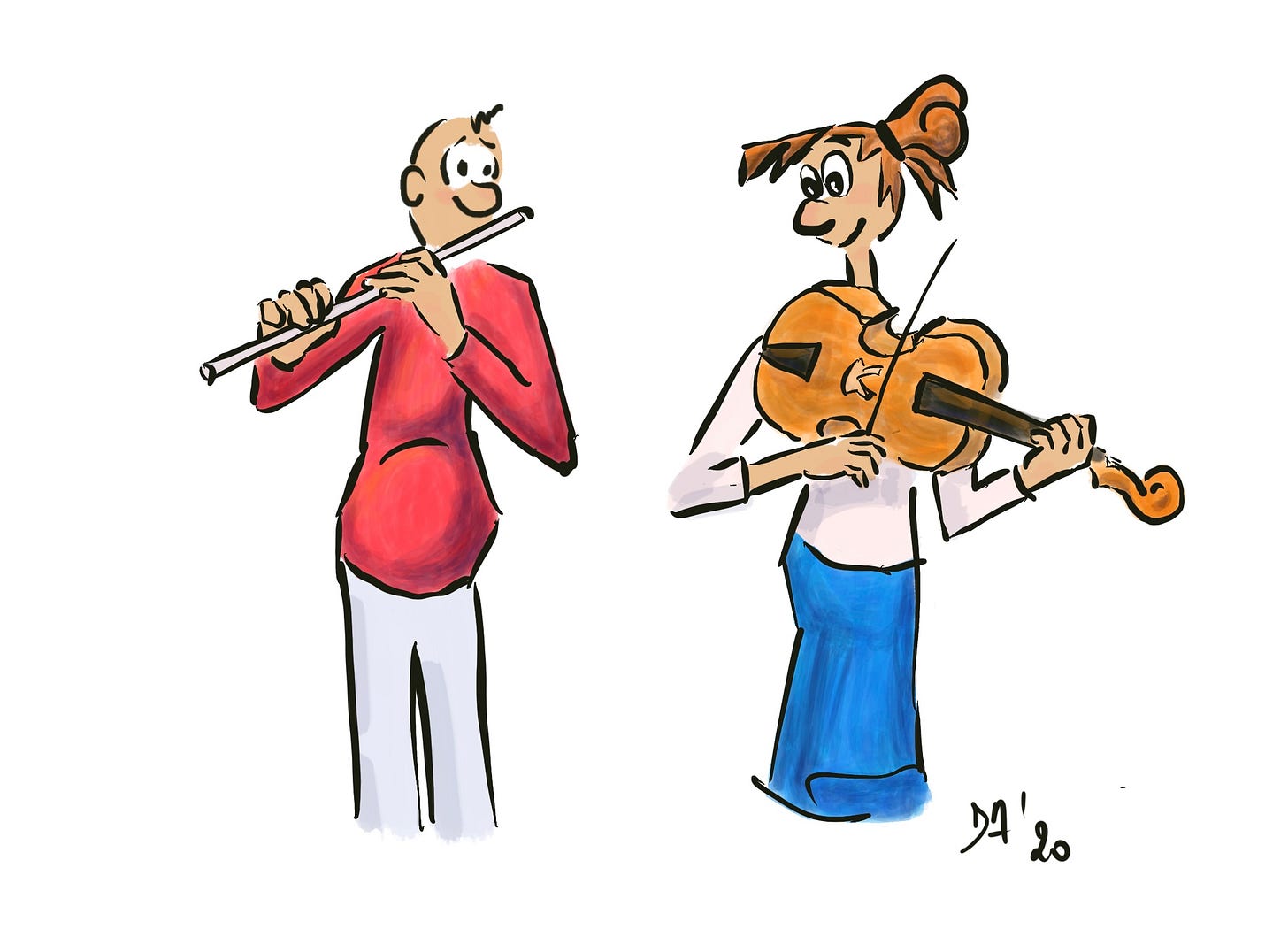
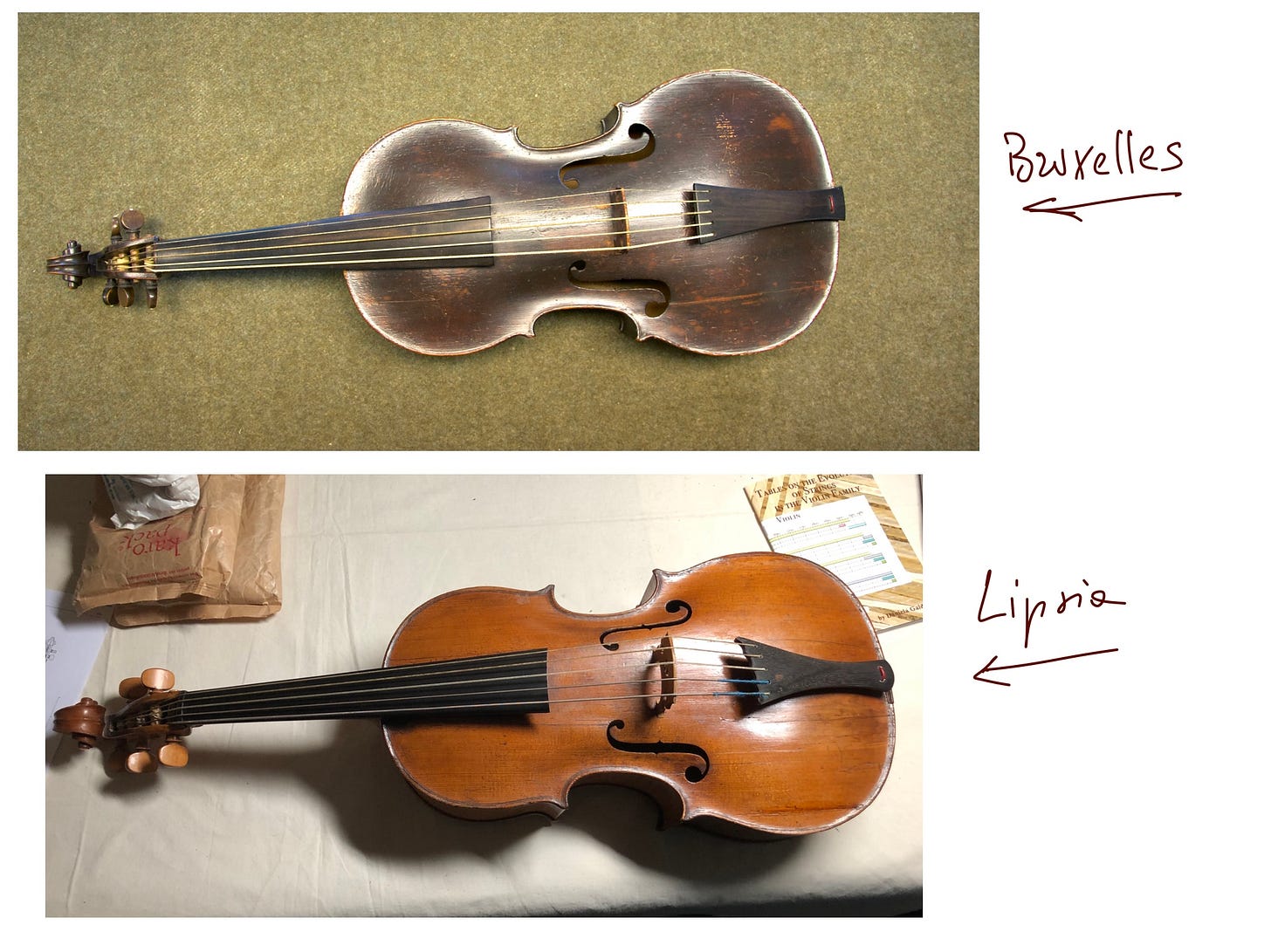
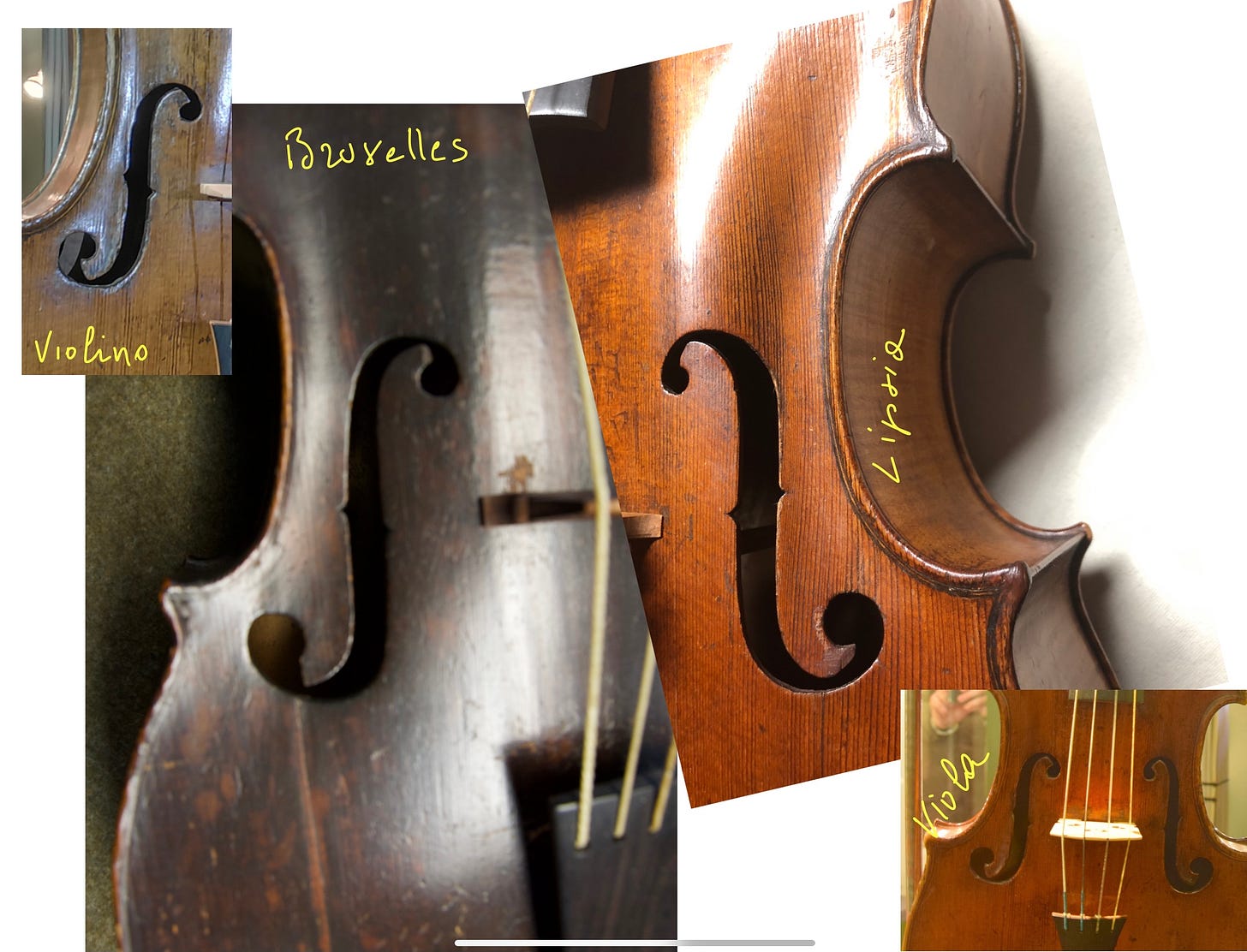
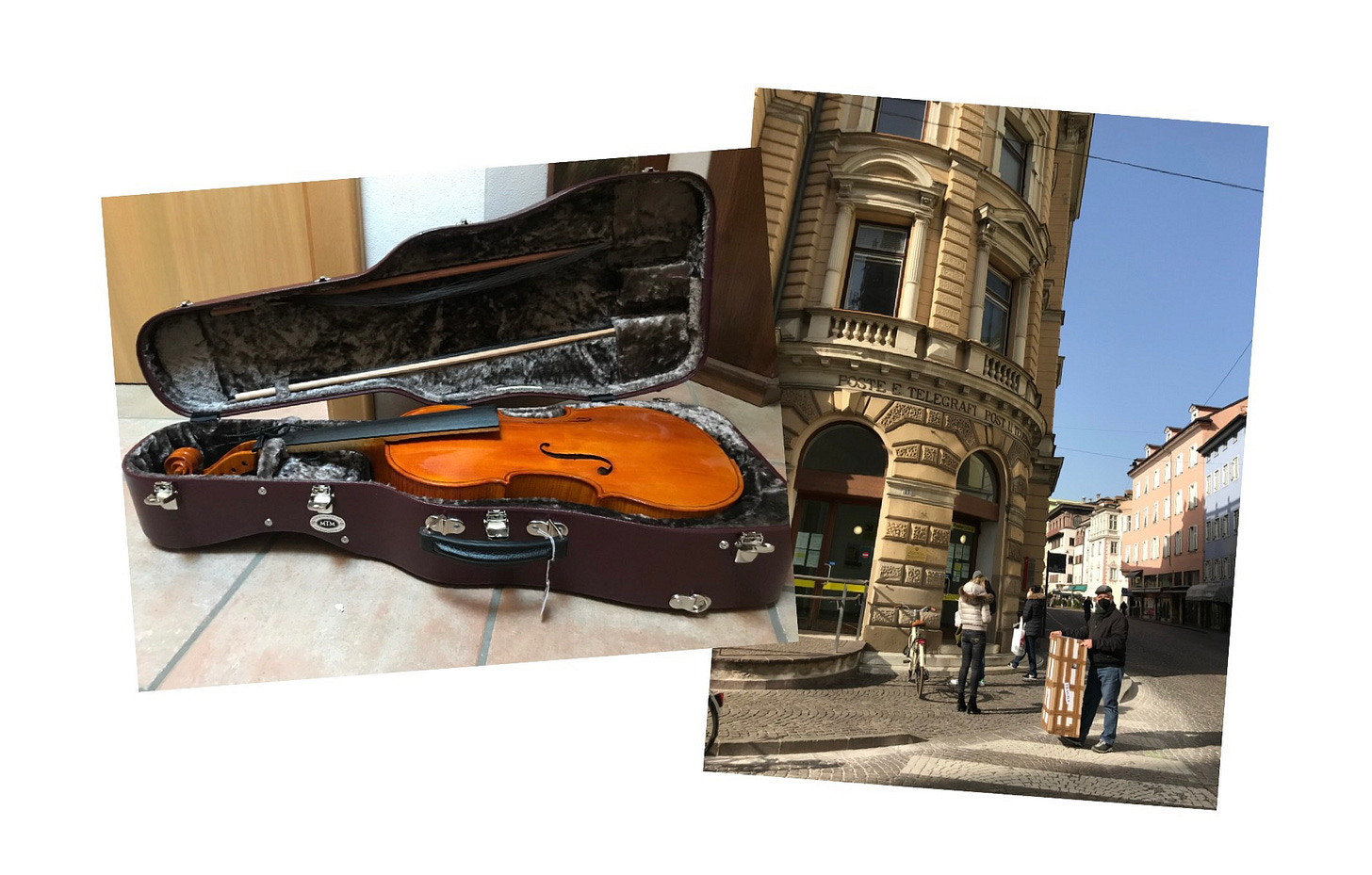
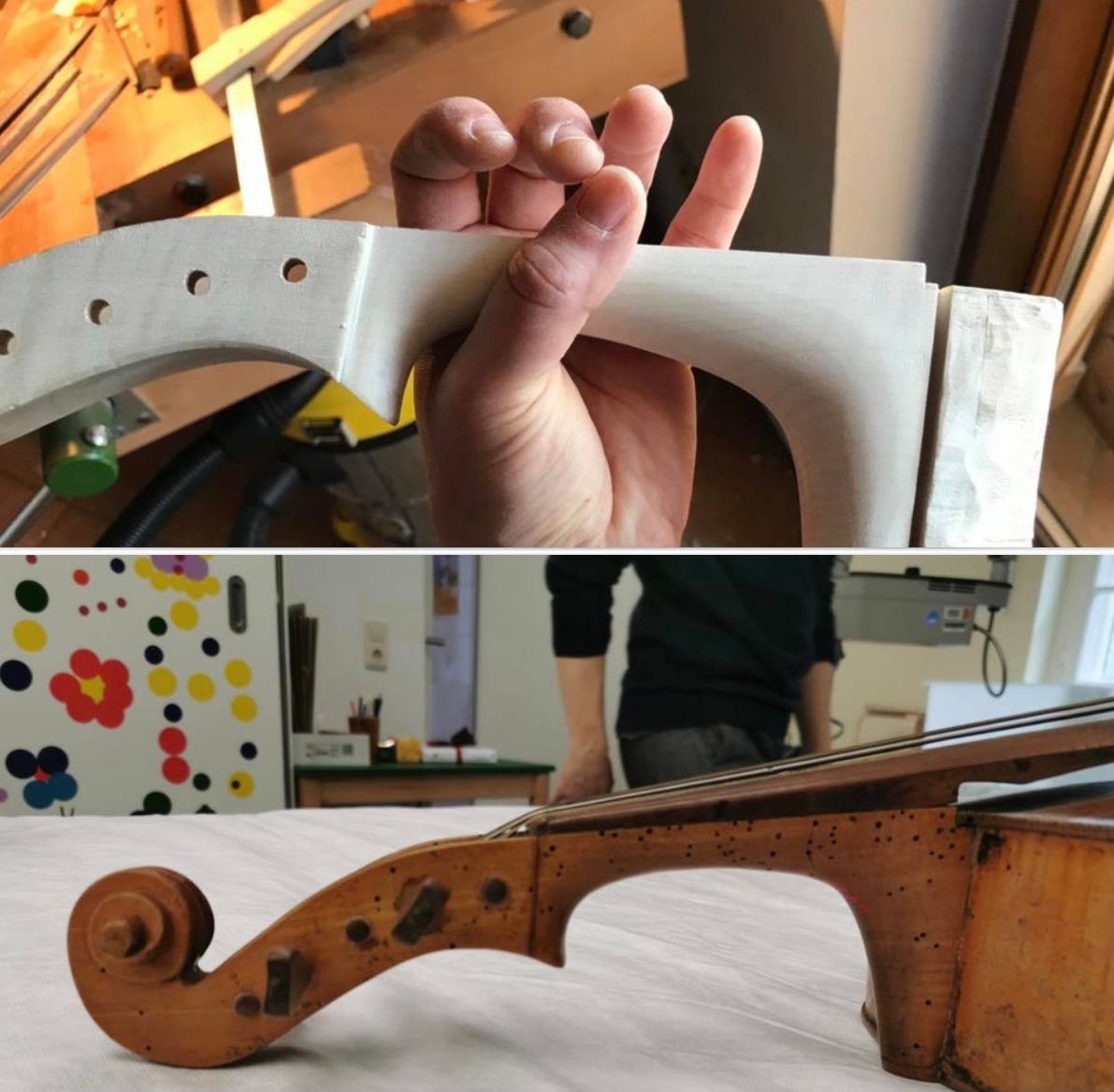

Some 21st century aberrations:
1. Performing hybrid baroque (e.g. synthetic strings but baroque bow, using a shoulder rest for violin, etc,)
2. Playing BWV1012 on a four string instrument
3 playing BWV1011 with standard tuning
4. Recording BWV1012 on violin but electronically adding a C string (done by an outstanding baroque performer. I intend no disrespect).
The spalla is real because it represents the unfixed and non-canonical world of baroque music making. A canon is antithetical to baroque music. It also represents the reality that a baroque professional musician was rarely confined to one instrument.
Thanks for this article. Very inspiring. I am learning to.play the cello da spalla and I got people asking me "Why are you playing a da spalla!? Upright cellos are so much louder"
Anyways, I would like to build me a cello da spalla and I was wandering if you can share your templates with me. I'm currently using a 1/8 Suzuki student cello to make my template, but I don't know if it's actually the same dimensions as the Badiarov da spalla. If you don't mind, send a personal message to samuel.antonanzas@gmail.com. Hoping to hear from you soon.